Physical Address
304 North Cardinal St.
Dorchester Center, MA 02124
Physical Address
304 North Cardinal St.
Dorchester Center, MA 02124

Master authentic rustic living room decoration with 20 essential principles for creating a soulful, timeless, and historically informed home.
Since the first shelters were built, the domestic hearth has been the very heart of our lives, evolving from a raw necessity into a space of profound comfort and character. This long history informs what a truly rustic living room should be. It’s not a style you can buy in a box; it’s a story told through weathered timber, honest stone, and the quiet marks of time.
Today’s most considered homes understand this truth: authentic rusticity isn’t an aesthetic, but a philosophy. It’s about honoring the past while creating a space that works beautifully for modern life. It requires a quiet respect for what came before and a practical eye for what is needed now. The 20 principles that separate a living room with soul from a mere decorated space haven’t changed in centuries. Let’s walk through them.
The soul of rustic design begins with a deep understanding of its own roots—its sense of place. This is not about trends; it’s about connecting a home to its landscape, its history, and the honest, simple ways things were built to last.
A historic home is like a palimpsest—a manuscript with layers of old writing still faintly visible beneath the new. Every scratch on a floorboard or worn spot on a windowsill is a part of that story. The essence of rustic design is learning to read these layers, not erase them. It’s about seeing the beauty in a home’s journey and its imperfections.

This means you must become a student of patina—the gentle sheen that develops on surfaces through age and use. You see it in the rich, deep color of an old pine beam or the softened edges of a stone step. Look for materials that have earned their character honestly. Reclaimed wood, salvaged brick, and hand-wrought iron hardware carry a story that manufactured materials simply cannot replicate. In your living room, this could be an antique armoire that grounds the room or simply leaving the original carpenter’s marks visible on an exposed beam. It’s a quiet act of stewardship.
So much of modern design is obsessed with sterile perfection. The Japanese philosophy of Wabi-Sabi offers a more profound way of seeing—it finds beauty in things that are “imperfect, impermanent, and incomplete.” For a rustic living room, this means celebrating the slight asymmetry in a hand-thrown pot, the natural knots in a wooden plank, or the subtle wear on a linen slipcover.
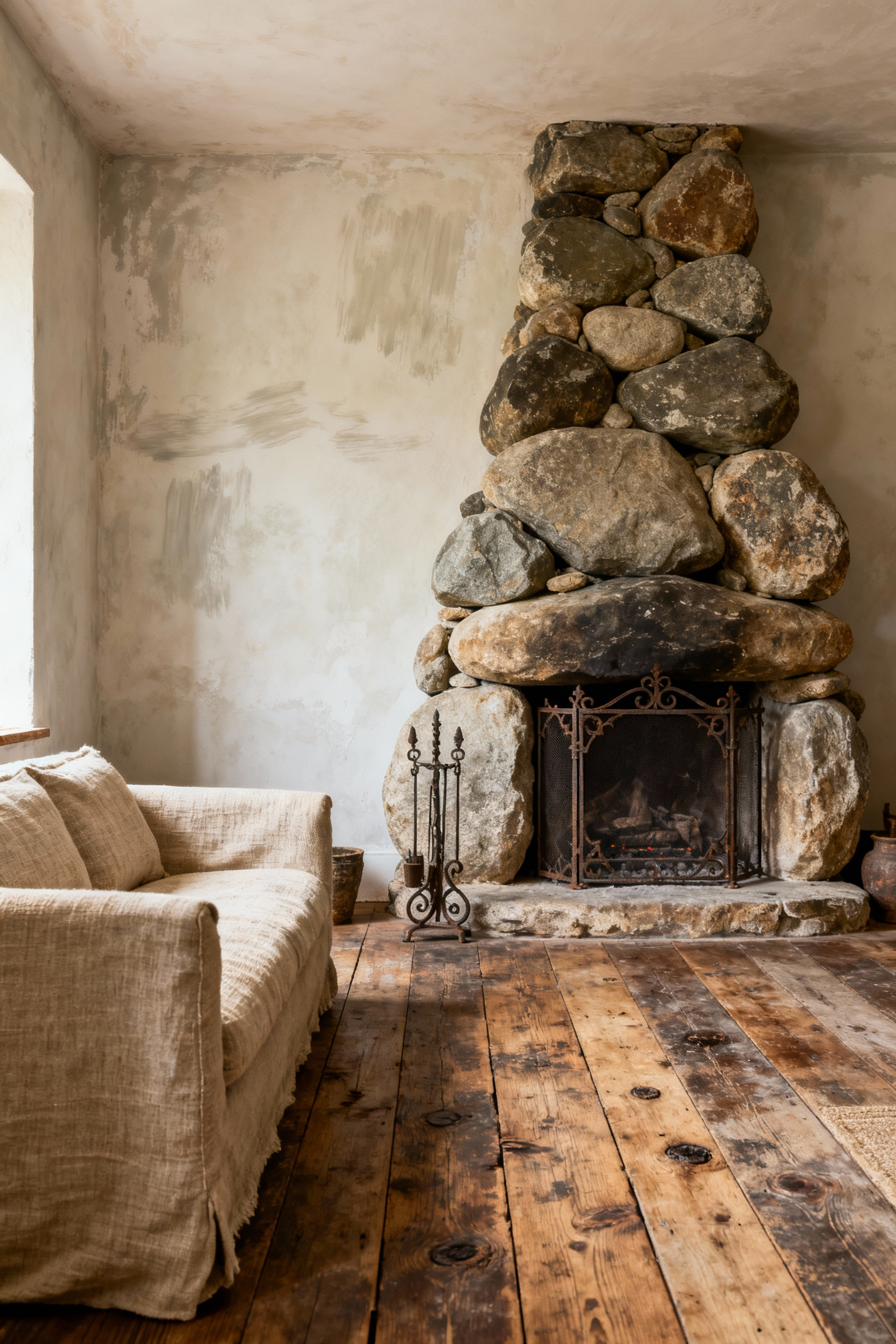
This leads you to a palette of natural, humble materials. Look for a live-edge slab of wood for a table, where the original shape of the tree is still present. Choose stone for a hearth that is left rugged and unpolished, revealing its geological texture. Select fabrics like coarse linen, wool, or undyed cotton that only grow softer and more beautiful with use. It’s about letting materials be themselves, with all their inherent character.
The word ‘terroir’ is often used for wine, describing how a place—the soil, the climate—shapes the final product. I believe the same is true for a home. An authentic rustic space feels connected to its specific region, its landscape, and its history. It honors the materials and craftsmanship that are native to its corner of the world.
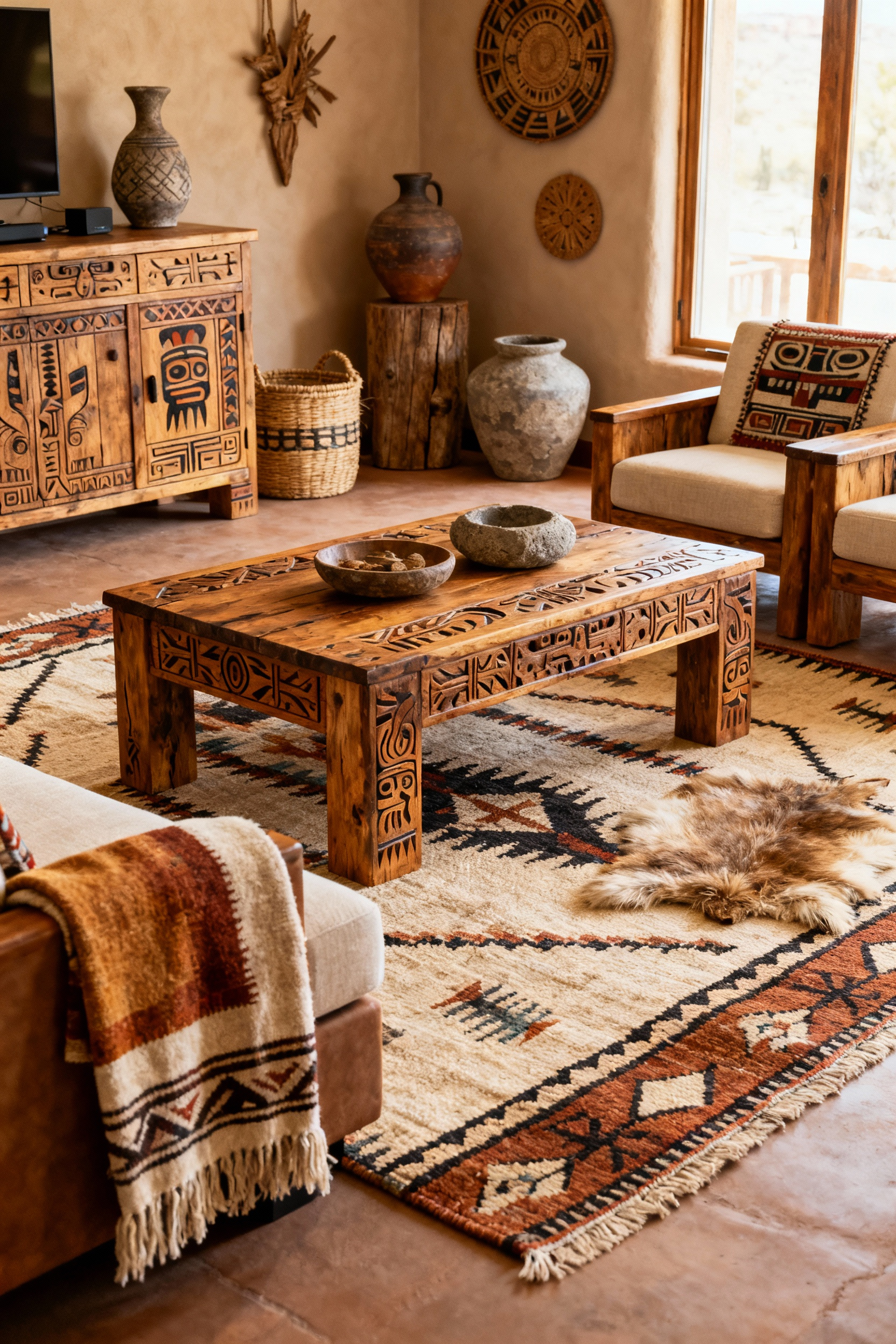
In my work with historical properties, I’ve seen this play out time and again. A farmhouse in Vermont should feel different from a ranch in Texas because the light, the trees, and the stone are fundamentally different. A rustic living room in the Cotswolds might feature honey-colored limestone, while one in the Pacific Northwest would naturally call for the deep tones of Douglas fir. Look for local artisans—a blacksmith who can forge hardware, a potter using local clay, or a weaver using traditional patterns. This not only creates a space with deep integrity but also supports the continuation of these vital crafts.
The most soulful rustic homes don’t just have a view of nature; they have a conversation with it. The line between indoors and outdoors should feel soft, almost porous. This isn’t just about putting a plant on a windowsill; it’s about designing the space so that the landscape becomes a fundamental part of the room itself.

Large, thoughtfully placed windows are crucial—they are not just openings, but frames for the living art outside. Materials should echo the exterior world: a stone hearth that reflects a rocky outcrop in the garden, wooden beams that feel like an extension of the forest canopy. Arrange furniture to orient toward the view. Allow natural light to be the primary source of illumination during the day, noticing how it shifts and changes with the hours. It’s about creating a sanctuary that feels sheltered, yet fundamentally connected to the earth.
This is perhaps the most important principle. Authentic design never pretends to be something it’s not. There is a world of difference between a solid oak beam that has held up a barn for a century and a hollow, plastic-laminate box designed to look like one. One has integrity, history, and physical weight. The other is a theatrical prop.

Choose solid, genuine materials at every turn. Celebrate your home’s original brickwork instead of covering it with thin veneer. Use real plaster or limewash that has textural depth, not wallpaper printed with a faux finish. Even in small things, opt for real pottery over mass-produced ceramics and handwoven textiles over synthetic lookalikes. A home built on honest expression has a quiet strength and dignity that cannot be faked. It becomes a space where you feel grounded, because everything around you is real.
The true character of a rustic space is written in its materials. It is the texture of the wood, the coolness of the stone, and the weave of the fabric that speaks of permanence and history. Choosing these elements is less about decoration and more about curating a story.
Time is the greatest artisan. When it comes to wood, we must learn to honor its work. Patina is the story of wood’s life—every sunbeam, every touch, every season is recorded on its surface. Instead of stripping it away to find a “perfect” new surface, our job is to preserve that history.
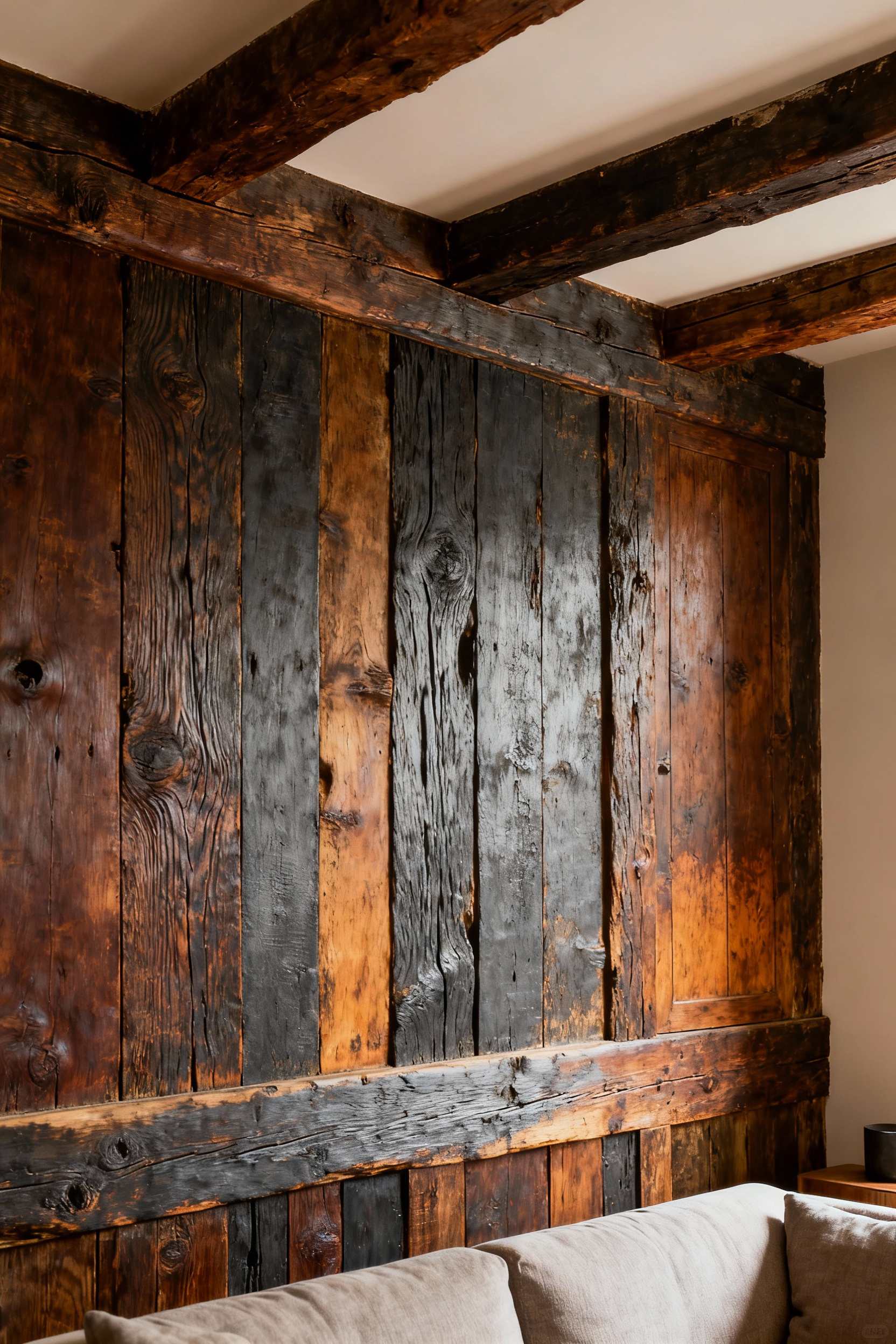
This means seeking out genuinely reclaimed wood—timbers from old barns, wide-plank flooring from decommissioned factories. These pieces possess a depth and character that new wood, even artificially “distressed” wood, can never achieve. In practice, preservation means gentle cleaning and perhaps sealing with a clear, matte finish that protects the wood without creating a glossy barrier. These timbers become the structural and spiritual backbone of the room, from imposing ceiling beams to a simple, sturdy mantelpiece.
Stone connects a home to the deep time of the earth itself. The most authentic choice is always the stone that belongs to the region—the indigenous stone that grounds the structure in its specific geological context. It speaks the language of the local landscape.
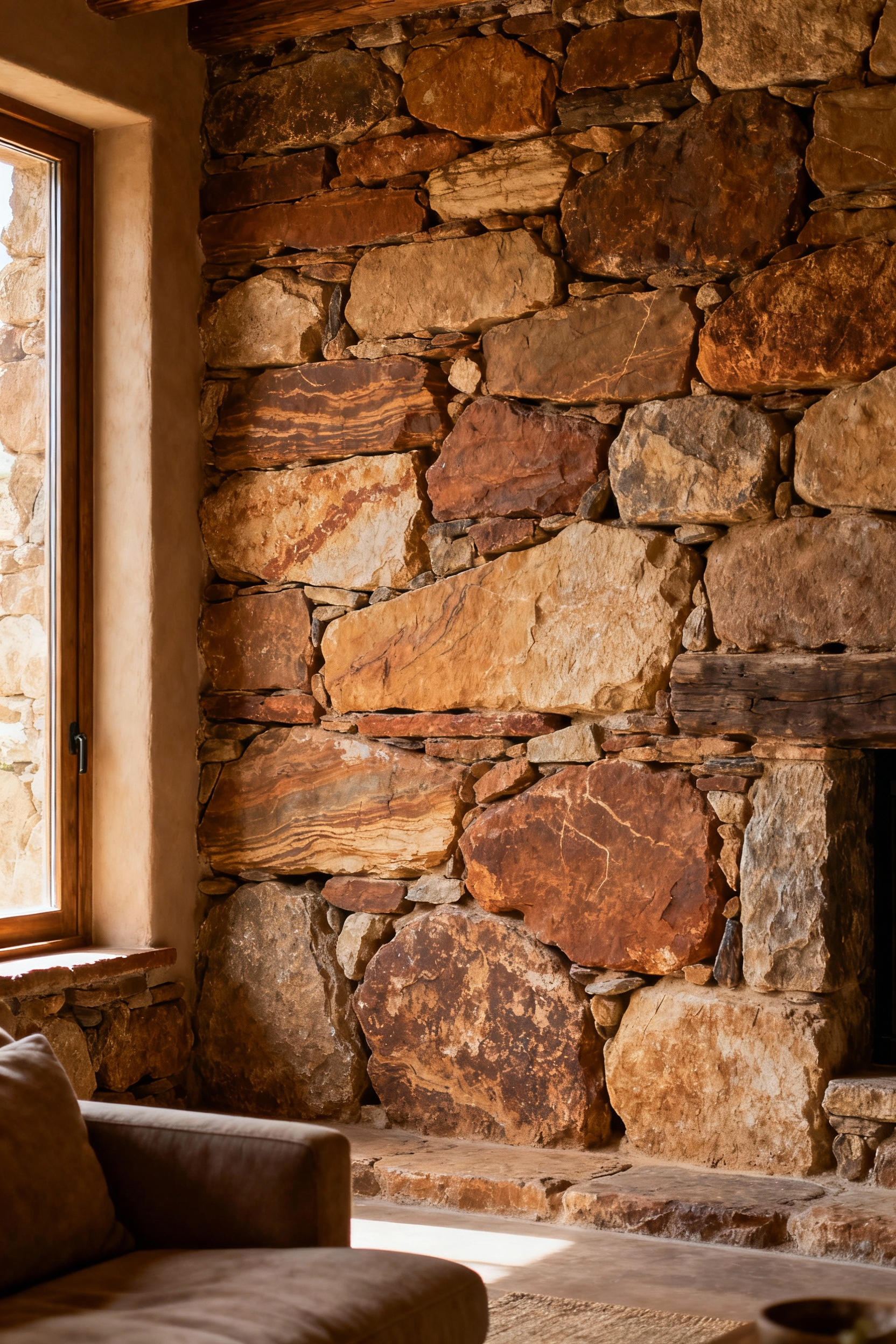
Fieldstone, gathered from the land and often bearing traces of moss, is perfect for a rugged, organic fireplace. Smooth river stones tell a story of water and time. In other regions, it might be slate, granite, or limestone. What I tell my clients and readers is this: listen to what the land around your home is made of. Building with local stone is a way of ensuring your home belongs to its place. Whether used for a hearth, a feature wall, or flooring, this stone provides an unwavering sense of permanence that anchors the entire space.
In a room of wood and stone, textiles provide the softness, warmth, and human touch. Mass-produced synthetic fabrics feel lifeless in contrast. The soul of a rustic living room is found in the honest, natural fibers worked by human hands.

Look for wool, linen, organic cotton, jute, and hemp. These materials are not only beautiful but also durable and sustainable. A hand-loomed wool rug, a heavy linen curtain that catches the light, or a chunky knit throw—these pieces have slight imperfections and variations in their weave that speak of their creation. They offer a rich tactile experience that invites you to touch, to curl up, and to feel truly comfortable. These textiles are meant to be used, loved, and passed down, becoming softer and more cherished with every year.
Metal provides the necessary punctuation in a rustic space—a note of strength and resilience. Hand-wrought iron, with its distinctive hammer marks and dark, honest finish, embodies the craft of the blacksmith. It’s a material of function and simple beauty, not superfluous ornament.
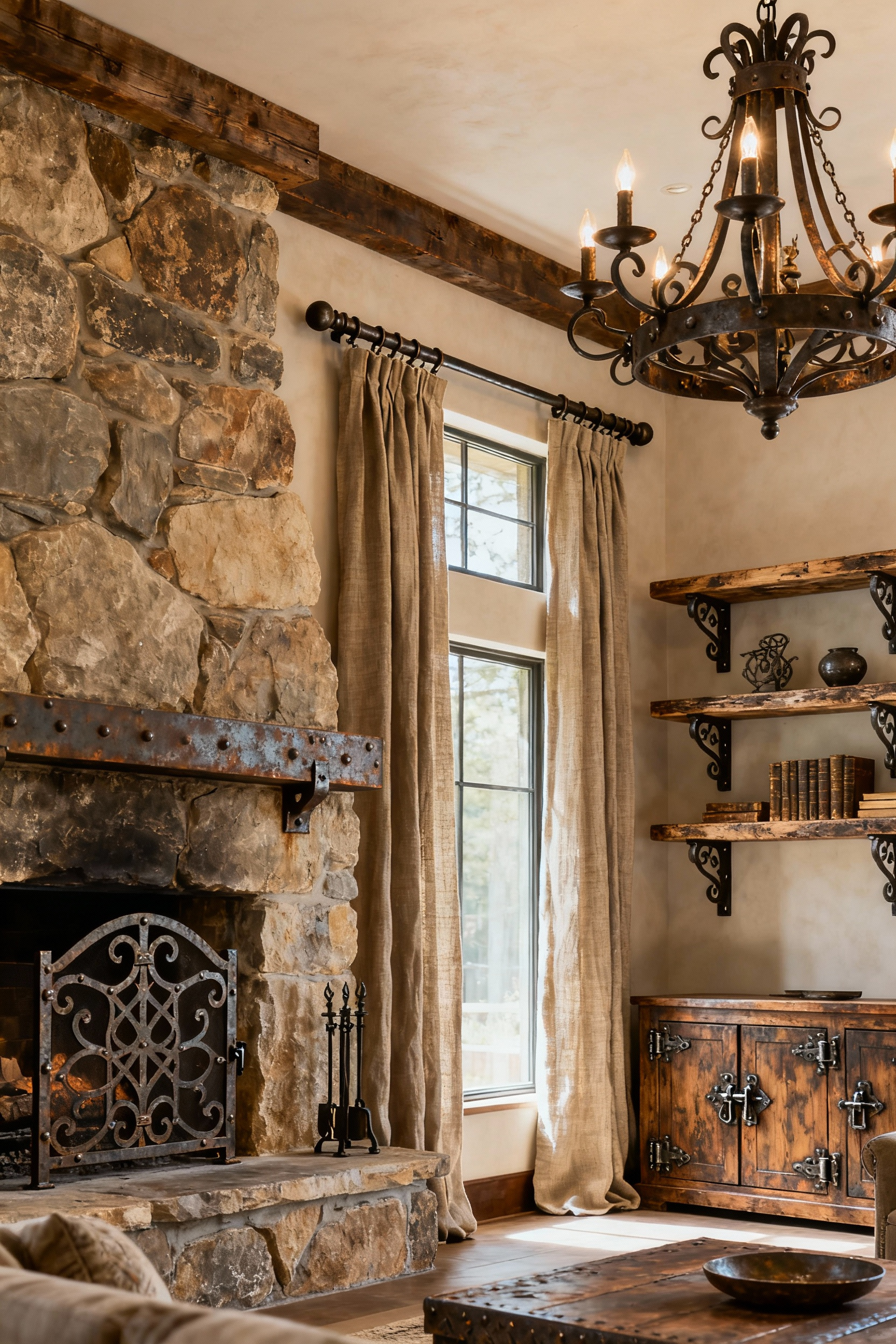
Incorporate these metals where strength is needed: a sturdy chandelier, fireplace tools, curtain rods, or cabinet hardware. Antiqued brass, hammered copper, or aged bronze can also add warmth and a sense of history. The goal is to choose metals that will continue to age gracefully, developing their own unique patina over time. These elements are not just decorative accents; they are the hardworking, unsung components that give a rustic room its structural and visual integrity.
The most timeless color palette is the one drawn directly from nature. Forget fleeting color trends. Look out your window. The colors for a rustic living room are there: the deep umber of damp earth, the complex grays of stone, the soft sage of wild grasses, the bleached beige of dried corn husks.
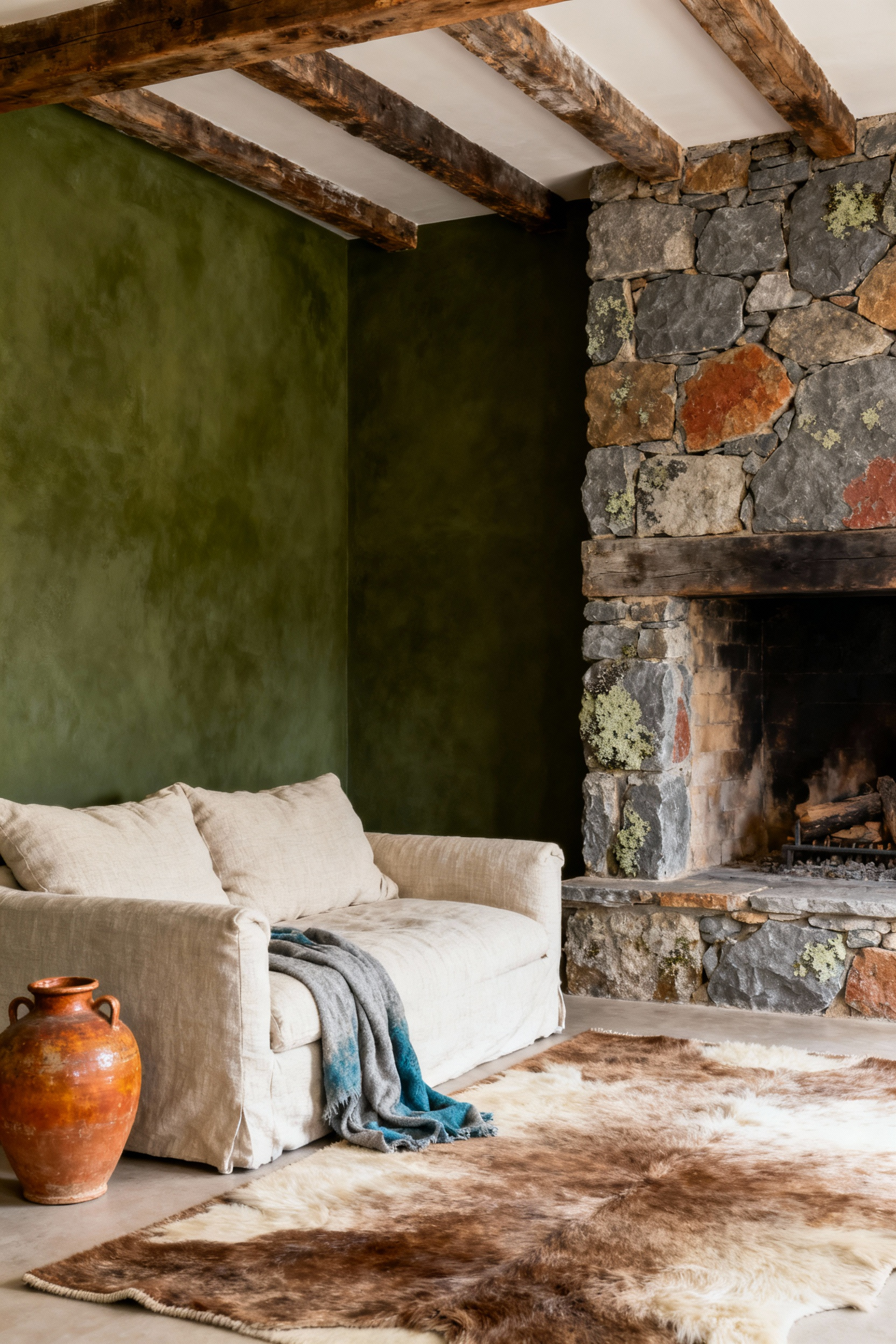
Start with a base of these muted, complex neutrals for your walls and large furniture. These are colors that feel calm and grounding. Then, layer in richer accent tones, also drawn from the natural world: the russet of autumn leaves, the deep green of a pine forest, or the moody blue of a stormy sky. This approach ensures a harmonious palette that feels inherent to the space, not imposed upon it. It creates an atmosphere of tranquility that connects the interior directly to the world outside.
Once you’ve established your material palette, the next step is to arrange the space. This is not just about placing furniture; it’s about shaping how life is lived in the room, creating a layout that is both practical for today and resonant with the past.
A rustic living room needs anchors. These are the large, substantial pieces of furniture that define the space and give it weight and presence. Think of a solid wood trestle table, a deep, comfortable sofa upholstered in durable linen, or a towering antique armoire. These pieces are the room’s architecture.
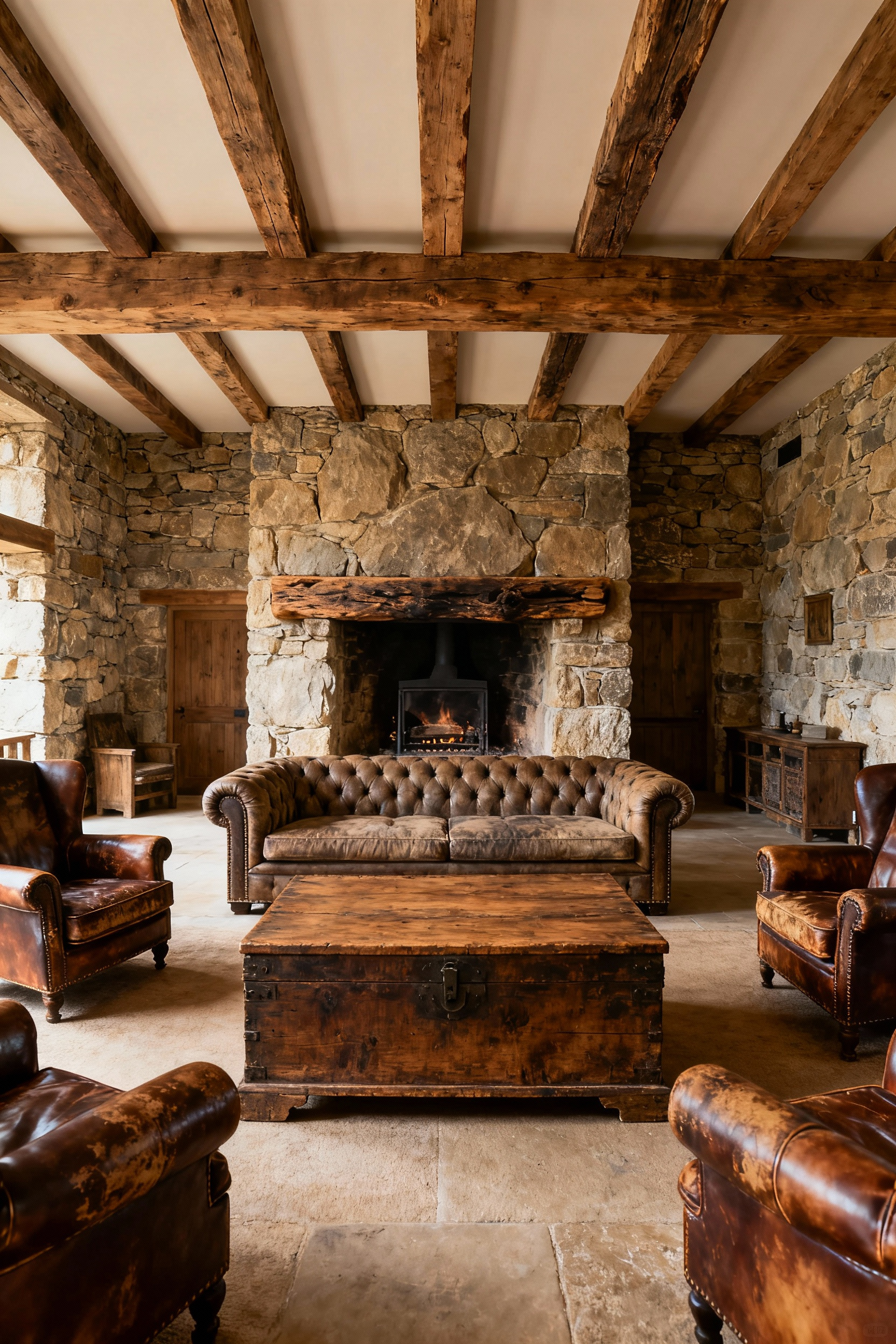
Place these anchors first to delineate the primary zones of the room—a space for conversation, a corner for reading. Their scale and solidity provide a sense of permanence and history. These are not trendy, disposable items; they are foundational pieces that will become part of the home’s legacy, grounding the space and the lives lived within it.
Lighting in a rustic home should feel as if it has evolved over time. Avoid harsh, centralized overhead lights. Instead, build layers of light to create a warm, inviting, and flexible atmosphere. Think of light as a tool for sculpting the mood of the room.
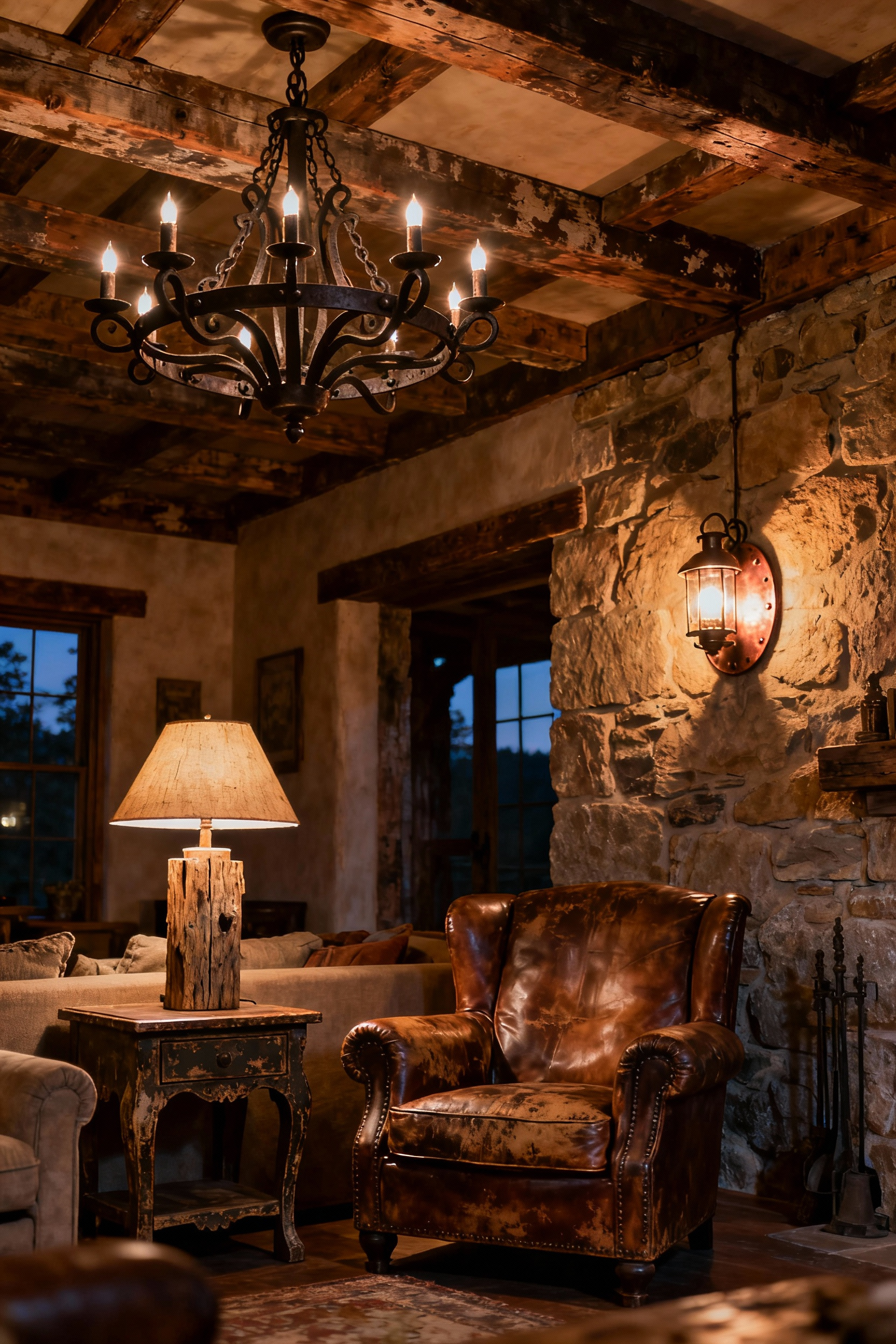
Start with ambient light from sources like a forged-iron chandelier or simple floor lamps that provide a soft, overall glow. Add task lighting where it’s needed—a reading lamp beside an armchair, for example. Finally, use accent lighting to highlight the room’s textures, such as a small lamp that washes light up an old stone wall. Choose bulbs with a warm temperature to evoke the gentle flicker of candlelight or a fire’s glow.
The fireplace is the primordial heart of a home. It is a symbol of warmth, safety, community, and sustenance. In a rustic living room, it should be the undeniable focal point, the gravitational center around which everything else revolves.
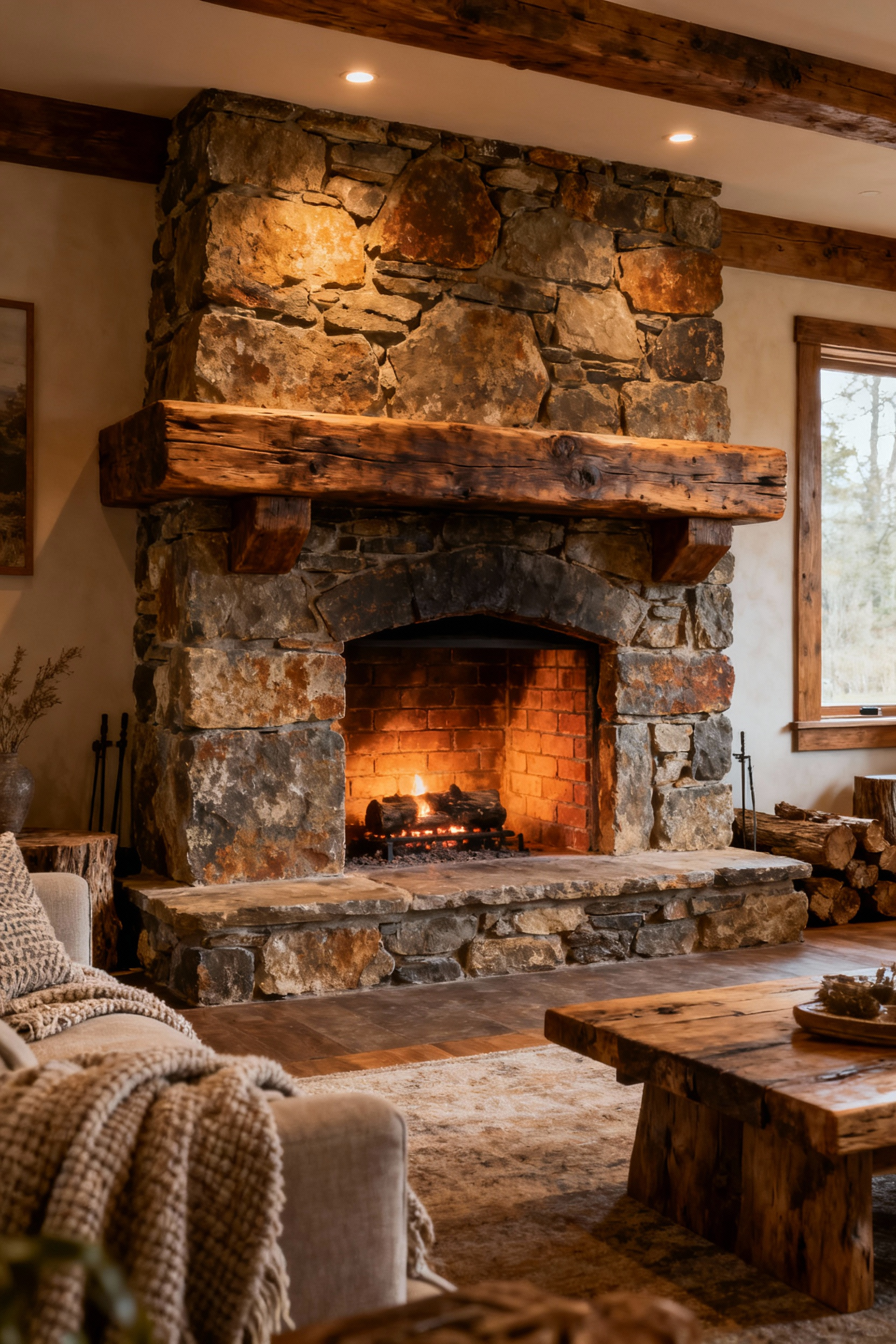
In almost every period restoration I undertake, the hearth is the starting point. It tells you where the social center of the house was, and we should listen to that wisdom. Design your seating arrangement to face the fireplace, creating a natural and inviting space for gathering. A substantial, roughly-hewn mantelpiece becomes a stage for cherished objects. The simple act of lighting a fire becomes a ritual that connects us to generations past, fostering conversation and quiet contemplation.
In keeping with the principle of honest expression, celebrate the very bones of your home. Instead of hiding the structure behind drywall, expose the original timber beams, stone walls, or brickwork. These elements tell the story of how the house was built and with what materials.
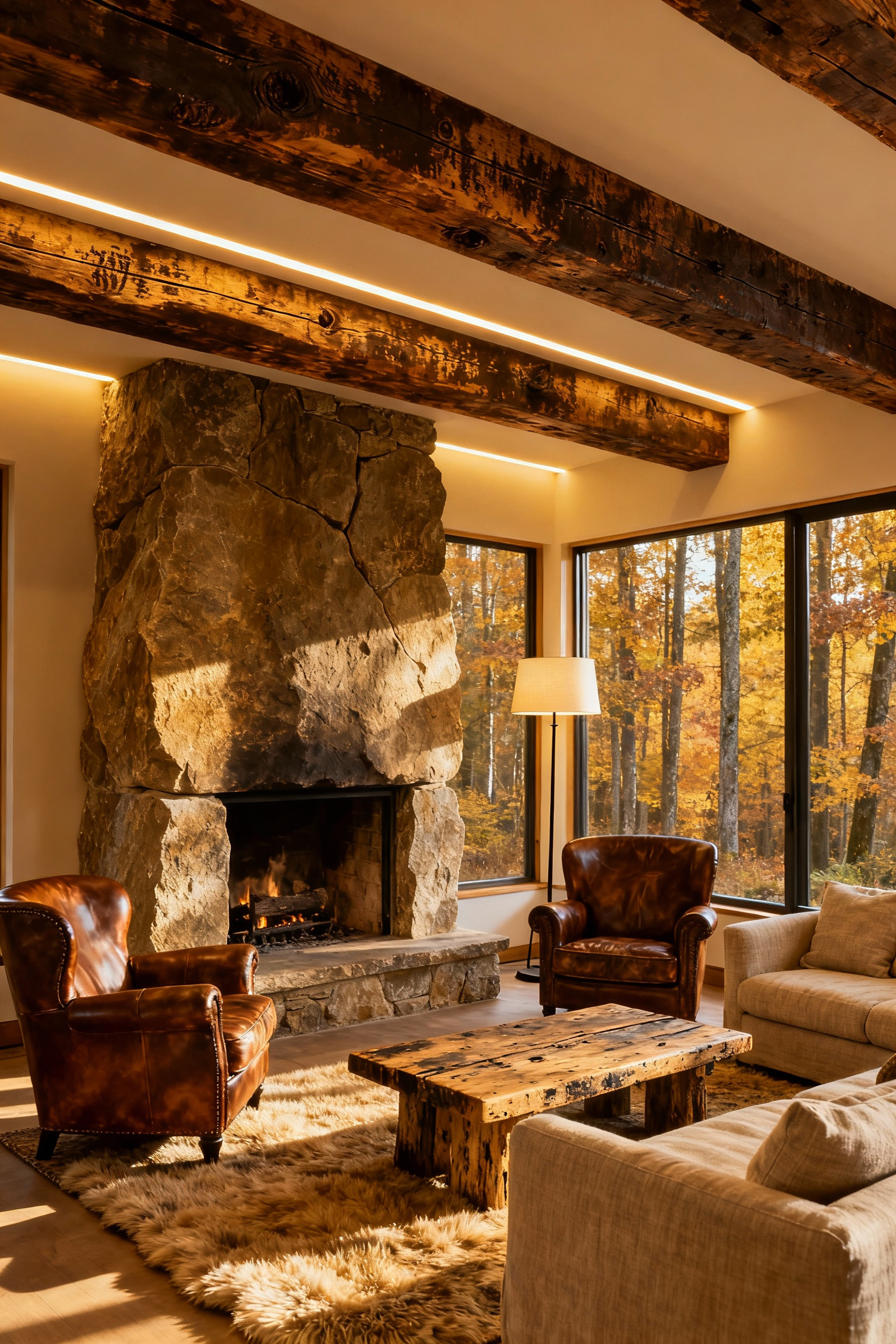
Exposed ceiling beams add immense character and a sense of scale, drawing the eye upward. A rugged stone wall provides a powerful textural backdrop. These are not decorative additions; they are the authentic, structural soul of the building. By revealing them, you are honoring the craftsmanship of the past and allowing the house to speak for itself.
Windows in a rustic home are more than just openings for light; they are picture frames for the natural world. Their placement and design should be a deliberate act of curation, thoughtfully composing the view and integrating the landscape into the daily life of the room.

Use simple, unadorned frames made of natural wood. Instead of one massive sheet of glass, consider groupings of smaller panes, which feel more traditional and architecturally sound. Then, create moments to enjoy the view—a deep window seat with cushions, or a pair of armchairs angled toward the scenery. By framing the landscape, you make it an active, ever-changing element of your interior.
The final layer is the most personal. It is about imbuing the space with sensory richness and the lived-in history that transforms a well-designed room into a soulful home. This is where comfort becomes more than a physical state—it becomes an emotional one.
Our sense of smell is powerfully tied to memory and emotion. A truly rustic home should smell of real things: the faint, pleasant scent of wood smoke from the hearth, the resinous perfume of pine, the clean fragrance of beeswax candles, or herbs drying from the rafters.

Avoid synthetic air fresheners, which create a chemical cloak. Instead, bring natural scents inside. Simmer a pot of water on the stove with cinnamon sticks and citrus peels in the winter. Arrange bundles of lavender or eucalyptus in simple vases. The goal is to create a subtle, layered aroma that is authentically tied to the materials of the house and the nature outside its walls.
A room should be as pleasing to the touch as it is to the eye. Layering a variety of textures creates a deep sensory richness that is profoundly comforting. It’s an invitation to engage with the space physically.
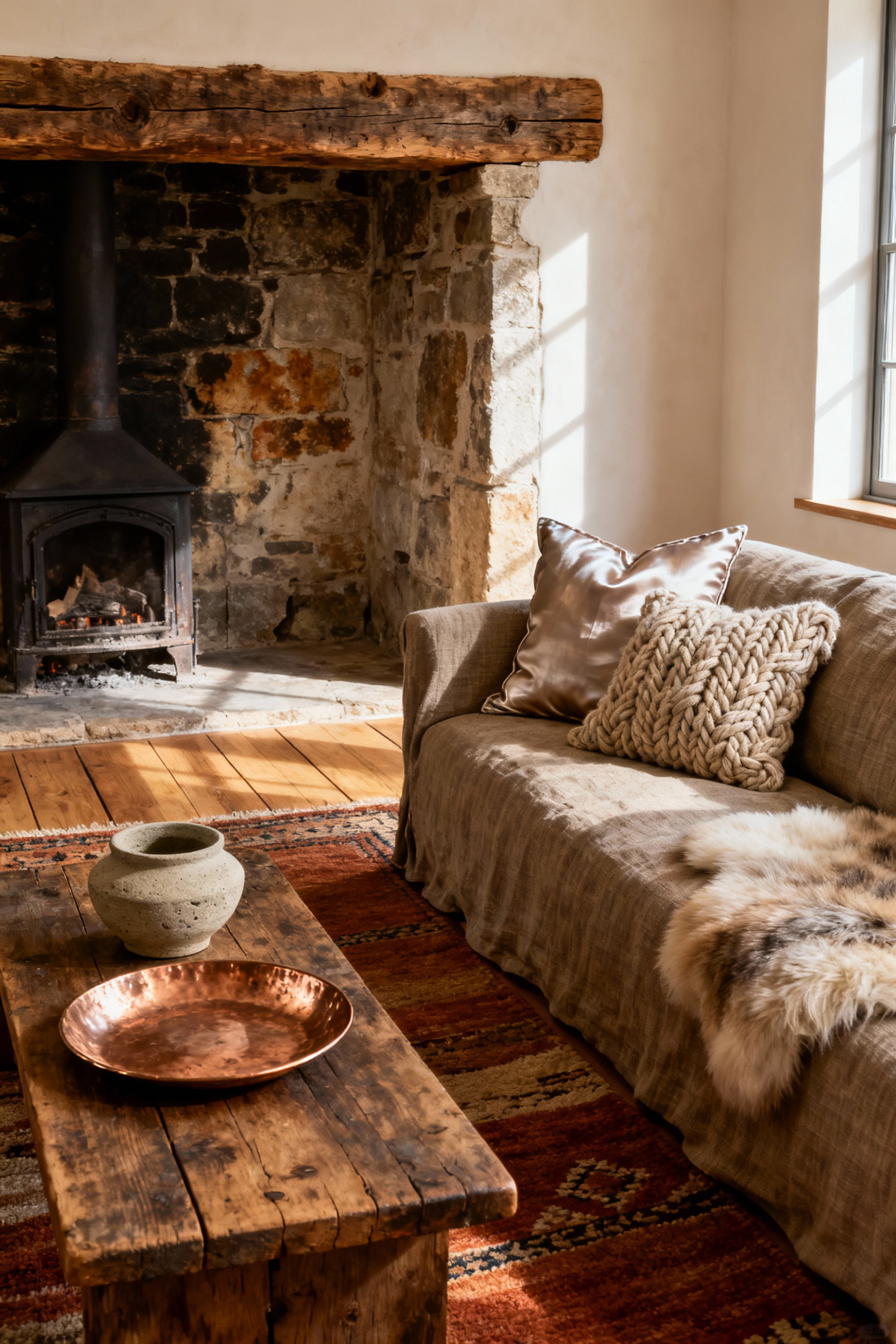
Juxtapose different textures: the coarse weave of a jute rug against the smooth coolness of a stone floor; the soft nap of a wool blanket on the rugged surface of a leather armchair; the nubby texture of raw silk pillows against a smooth linen sofa. In my professional experience, a lack of textural variety is what often makes a room feel flat and uninviting, no matter how well-appointed. These layers add visual depth and create a haptic environment that feels safe, warm, and endlessly inviting.
Incorporate objects that have a history and a patina of their own. This is not about clutter; it’s about thoughtful curation. These artifacts connect your home to a lineage of human experience.
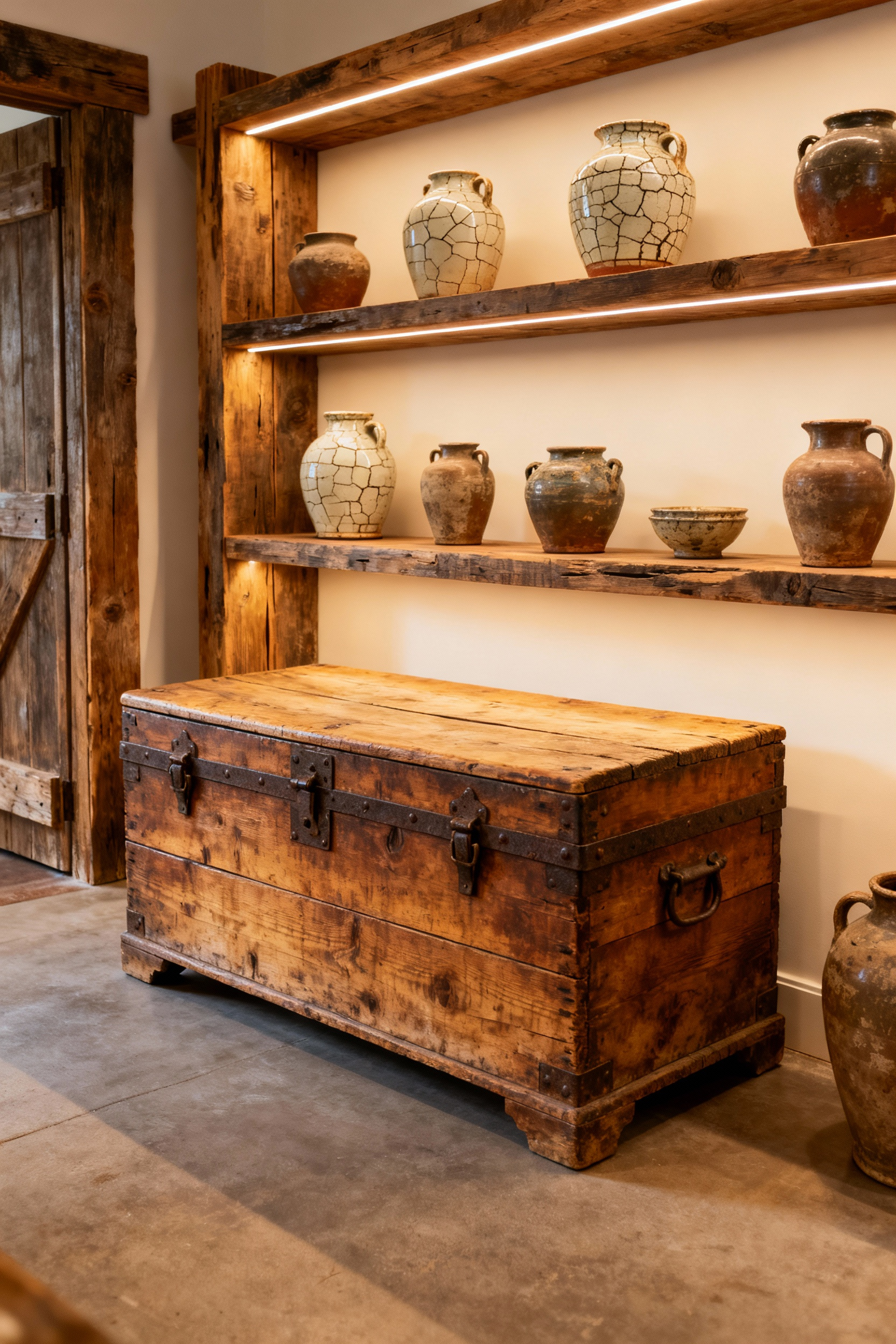
This could be a collection of old, hand-thrown pottery on a shelf, a vintage tool repurposed as a sculptural object, or a weathered wooden chest used as a coffee table. Each of these items carries the marks of a previous life. They provide focal points that spark curiosity and conversation, imbuing the room with a sense of continuity and a soul that cannot be bought new.
Often overlooked, the sound of a room is critical to its feeling of comfort. Rooms with too many hard surfaces—wood floors, stone walls, large windows—can feel cold and loud, with sounds echoing unpleasantly. We need to create an “acoustic envelope” to soften the space.
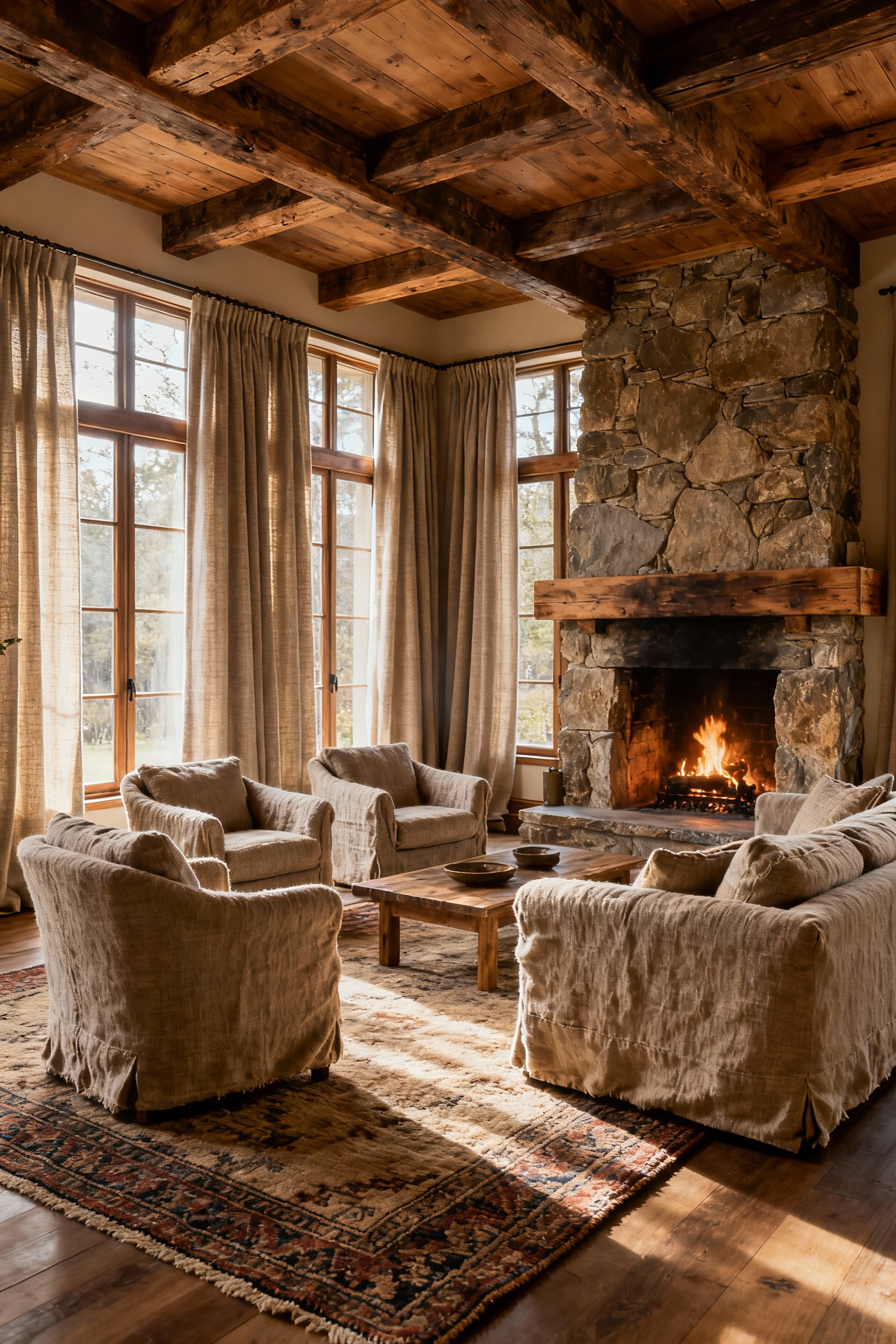
Heavy drapery made from wool or linen, large upholstered sofas and armchairs, and thick, pile-woven rugs are essential. These soft materials absorb sound, creating a calmer, more intimate atmosphere. In a well-designed acoustic space, conversations are clearer, music sounds richer, and the simple sound of a crackling fire becomes the main event.
Finally, remember that a living room is for living—and living is often done in the company of others. Arrange your seating not just for aesthetics, but to encourage real connection and conviviality.

Instead of lining furniture up against the walls, create intimate groupings that face each other. Pull chairs in closer around the hearth or a central coffee table. The goal is to design a space where conversation flows naturally and where people feel drawn together. This transforms the room from a static showroom into a dynamic stage for the small, beautiful moments of daily life. Your seating should tell a story of welcome.
As we’ve explored these twenty principles, a central theme emerges: authentic rustic design is a practice of mindfulness. It is a thoughtful departure from the world of the disposable and the superficial, and a return to what is real, lasting, and deeply human. It is about crafting a home that feels as if it has grown out of its landscape over time, a place where every material tells a story and every object has a purpose.
Your rustic living room should be more than a collection of beautiful things; it should be a sanctuary that reflects a commitment to craftsmanship, honesty, and a connection to the natural world. It should be a space that is not only seen but felt—a room that offers comfort to the body and peace to the soul. I encourage you to use these tenets not as rigid rules, but as a guide to help you listen to your own home’s story, and to create a living space that will resonate with warmth and authenticity for generations to come.